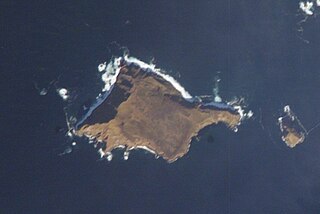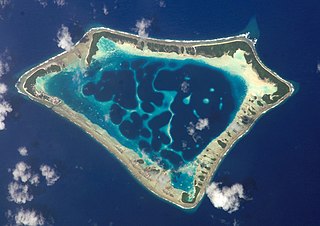
Adak Island is an island near the western extent of the Andreanof Islands group of the Aleutian Islands in Alaska. Alaska's southernmost town, Adak, is located on the island. The island has a land area of 274.59 square miles (711.18 km2), measuring 33.9 miles (54.5 km) on length and 22 miles (35 km) on width, making it the 25th largest island in the United States.

Kanaga Island is a part of the Andreanof Islands group of the Aleutian Islands in Alaska. The island measures 30 miles (48 km) long and between 4–8 miles (6.4–12.9 km) wide with an area of 142 sq mi (368 km2), making it the 42nd largest island in the United States. The island's most notable feature is Mount Kanaga, a 4,288-foot-high (1,307 m) volcano which last erupted in 1995.

Khvostof Island or Atanak is an island in the Rat Islands archipelago of the Western Aleutian Islands, Alaska. The island is 2 kilometres (1.2 mi) long and 2.74 kilometres (1.70 mi) wide.

Amatignak Island is a member of the Delarof Islands, in Alaska's Aleutian archipelago. The southernmost point of Alaska is on this island, as well as the westernmost longitude of Alaska, the United States, and North America.

The Delarof Islands are a group of small islands at the extreme western end of the Andreanof Islands group in the central Aleutian Islands, Alaska. The Delarofs consist of 11 named islands: Amatignak, Gareloi, Ilak, Kavalga (Qavalĝa), Ogliuga (Aglaga), Skagul (Sxaĝulax̂), the Tags (Tagachaluĝis), Tanadak (Tanaadax̂), Ugidak (Qagan-tanax̂), Ulak, and Unalga (Unalĝa).

Great Sitkin Island is a volcanic island in the Andreanof Islands of the Aleutian Islands of Alaska. The island covers a total area of 60 square miles (160 km2) and lies slightly north of a group of islands which are located between Adak Island and Atka Island.

Igitkin Island is a small island located in an area between Adak Island and Atka Island among other small islands. The island belongs to the Andreanof Islands of the Aleutian Islands of Alaska.

Kagalaska Island is an island in the Andreanof Islands of the Aleutian Islands of Alaska.

Tagalak Island is an island located in the central area of the Andreanof Islands of the Aleutian Islands of Alaska. West of the island lies Chugul. The island is 6.3 kilometres (3.9 mi) long and 7 kilometres (4.3 mi) wide.

Ulak Island is an island in the Delarof Islands subgroup of the Andreanof Islands in the Aleutian Islands chain of Alaska.

Umak Island is an island lying in a group of small islands situated between Adak Island and Atka Island in the Andreanof Islands group of the Aleutian Islands of Alaska. It is 11.7 kilometres long and 7.8 kilometres wide.

Yunaska is the largest of the Islands of Four Mountains group in the Aleutian Islands of southwestern Alaska, United States. It has a land area of 66.834 square miles and no population at the 2000 census.

Unalga Island is one of the Fox Islands subgroup of the Aleutian Islands of southwestern Alaska, United States. It lies just northeast of Unalaska Island and across Akutan Pass from Akutan Island to its northeast. It is the westernmost island in the Aleutians East Borough. Unalga Island has a land area of 11.004 square miles and is unpopulated. The island is 6.7 kilometres (4.2 mi) long and 8.2 kilometres (5.1 mi) wide.

Akun Island is one of the Fox Islands subgroup of the Aleutian Islands in the Aleutians East Borough of southwestern Alaska.

Egg Island is a small island in the Fox Islands subgroup of the Aleutian Islands in the U.S. state of Alaska. It lies off the eastern end of Unalaska Island and just off the northeastern tip of Sedanka Island. It is the easternmost island in the Aleutians West Census Area of Alaska. The island has a land area of 311.12 acres (1.259 km²) and is uninhabited. It is 19.3 kilometres (12.0 mi) long and 12 kilometres (7.5 mi) wide.

Tanaga Island is an island in the western Andreanof Islands, in the southwest part of the Aleutian Islands, Alaska. The island has a land area of 204 square miles, making it the 33rd largest oceanic island in the United States. Its highest point is volcano Mount Tanaga at 5,925 feet.

Herbert Island is an island in the Islands of Four Mountains subgroup of the Aleutian archipelago. It is 3.1 miles (5.0 km) from Chuginadak Island, separated by the Chuginadak Pass. Yunaska Island is 16 miles (26 km) northwest of Herbert Island. Measuring 6.2 miles (10.0 km) across, Herbert Island is somewhat circular in shape and is covered by the 4,200-foot (1,300 m) Herbert Volcano, whose 2-kilometre (1.2 mi) wide caldera is one of the largest in the Aleutian Islands. There have been no recorded eruptions here.

Aziak Island is a small island in the Andreanof Islands group in the Aleutian Islands of southwestern Alaska. The name "Aziak" is derived from the Aleut word ha-azax - "ten," and in many books and charts published before 1920, it was often used to refer to Sledge Island, located 930 miles (1,500 km) to the northeast off the Seward Peninsula, or to a native settlement on that island. This practice apparently became rarer as the twentieth century progressed and today Aziak is used almost exclusively to refer the Andreanof-group island. Aziak Island is approximately 1.1 miles (1.8 km) long and reaches a maximum elevation of 190 feet (58 m). Very little is known about the island and it is uninhabited.

Akutan Island is an island in the Fox Islands group of the eastern Aleutian Islands in the Aleutians East Borough of Alaska.





